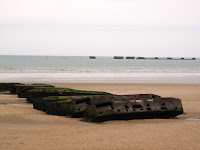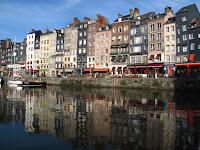

Having visited St Michael's Mount in Cornwall, we have always wanted to visit it's bigger, older counterpart in France. Le Mont St Michel is a two hour drive from Honfleur, and an absolutely stunning silhouette on the sky-line as you approach.
The Abbey is at the top of the mount, the town at the base, and the whole adds up to Le Mont-St-Michel.

We took the trail through the Abbey, and tried to imagine life in the days of the monks.
From here we went to Bayeux, our second World Heritage stop for the day. This is of course where the famous Bayeux Tapestry resides.

Probably commissioned by Otto, Bishop of Bayeux, who was William the Conqueror's brother, the tapestry is a 70 metre long embroidered story of William's invasion of England in 1066. A very efficient system of an audio guide telling the stories and pointing out details in the tapestry, keeps tardy tourists moving along.
Mont-St-Michel is featured in the Tapestry, and the audio-visual showed the WWI cemetery in Bayeaux, which has inscribed in Latin

“We the descendents of the people conquered by William, liberated his homeland.” After visiting the cathedral where the Tapestry hung for 700 years, the quote provided the continuity link to our last activity for the day, the D-Day Landings. Bayeaux was one of the first towns to be liberated after the American and British troops landed on June 6th 1944, and this major operation helped to end the war.

We were able to visit the Pointe du Hoc high cliffs which the Americans scaled, using ladders loaned by the London Fire Department. Crater holes and remains of gun emplacements are still at the top of the cliffs.

Further east at Longues-sur-Mer, we saw canons still in place within the gun batteries, but most spectacular of all were the huge concrete caissons floated from Britain to form a Mulberry Harbour, named Port Winston. We visited at low tide, and a semi-circle of these are still in place in the bay. The harbour was built in a matter of three days, and half a million vehicles passed over it in the next ten months.

 Sadly, this was the last day of our Safari, but there was time for one last drive through the Masai Mara reserve, on the way to the main gate. We didn't see any new animals, but it was a chance to see more of those we had already seen. This time it was
Sadly, this was the last day of our Safari, but there was time for one last drive through the Masai Mara reserve, on the way to the main gate. We didn't see any new animals, but it was a chance to see more of those we had already seen. This time it was  a herd of buffalo that were “up close and personal”. On the drive home, we again saw zebras and wildebeests outside the park, and this time a group of about ten giraffes.
a herd of buffalo that were “up close and personal”. On the drive home, we again saw zebras and wildebeests outside the park, and this time a group of about ten giraffes.















































